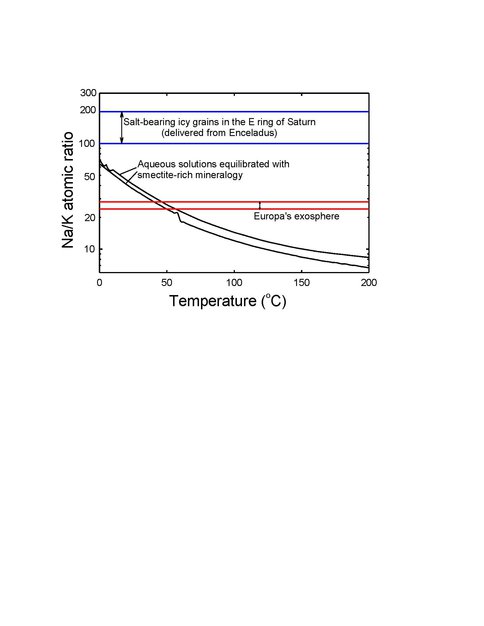2012 Annual Science Report
 Arizona State University
Reporting | SEP 2011 – AUG 2012
Arizona State University
Reporting | SEP 2011 – AUG 2012
Habitability of Water-Rich Environments, Task 3: Evaluate the Habitability of Europa's Subsurface Ocean
Project Summary
Europa is of keen interest to astrobiology and planetary geology due to its indications of a sub-surface ocean. Understanding of Europa’s oceanic composition and pH is important to evaluate habitability of the icy moon. Knowledge of the global distribution and timing of Europan geologic units is a key step for understanding the history of the satellite and for identifying areas of recent activity. We are evaluating the habitability of a subsurface ocean of Europa through evaluation of chemical composition and salinity of oceanic water. We use numerical approaches to model interaction of possible rocks on Europa with water formed through melting of ices. In addition, we use chemical and mineralogical signs of water-rock interactions in carbonaceous chondrites as a proxy for aqueous processes on Europa.
Project Progress
Co-I M. Zolotov has evaluated the composition of fluids formed through aqueous alteration of CI-type carbonaceous chondritic materials at possible environments of the ocean-rock interface on Europa. Chemical equilibria in water-chondrite type systems were calculated for ranges of initial fluid compositions, water to rock ratios, temperatures, and pressures. In open system models, fugacity of hydrogen was fixed as well. In the closed system models, calculated aqueous solutions have alkaline pH and are rich in alkali, chloride, and carbonate species (Na+, Cl-, HCO3-, CO32-, OH-, NaCl, K+, etc.). Abundances of these species depend on conditions of alteration. We conclude that Na-, Cl-, and carbonate-bearing species could be abundant in the subsurface ocean of Europa.
This work also demonstrates that sulfate species detected on the surface of Europa have negligible concentrations in closed system models, at which hydrogen does not leave the ocean. To explore formation of sulfates, we performed open-system runs and vary fugacity of H2 to explore effects of H2 escape. The results show that elevated temperature and low hydrogen fugacity favor formation of sulfate-bearing fluids rich in Mg, Na, K, and Cl. These solutions form through oxidation of sulfides and increasing solubility of magnesium phyllosilicates (serpentine and saponite) that supply cations. The results show that formation of sulfate ions increases salinity and ionic strength of solutions. Therefore, oxidized sulfate-bearing ocean on Europa would be more saline than reduced NaCl-NaHCO3 type ocean. This work shows that formation of MgSO4-rich solutions suggested in the ocean requires elevated temperatures, H2 escape, or a presence of strong oxidants. These results are consistent with our previous evaluations that were based on less sophisticated approaches.
Previous works demonstrate that the Na/K ratio in the atmosphere of Europa could reflect the composition of the ocean. In turn, our models show that the Na/K ratio in rock alteration fluids depends on temperature, as illustrated in the figure. We argue that the low atmospheric Na/K ratio compared to modeled fluids is consistent with hydrothermal processes at the bottom of the ocean.
The modeled Na/K ratio in fluids formed through aqueous alteration of CI carbonaceous chondrite solids as a function of temperature (modified from Zolotov, 2012). These fluids (shown by black curves) could characterize parent bodies of carbonaceous asteroids several million years after formation of the solar system, as well as compositions of subsurface oceans on icy moons. The blue horizontal lines show the range of Na/K ratios in icy grains emitted from Enceladus’ (Postberg et al., 2009). The lower dotted lines correspond to the exosphere of Europa that may characterize the moon’s subsurface ice and an ocean (Cipriani et al., 2009). If compared with modeled fluids, these data indicate lower temperature of aqueous processes on Enceladus than on Europa.
Publications
-
Zolotov, M. Y. (2012). Aqueous fluid composition in CI chondritic materials: Chemical equilibrium assessments in closed systems. Icarus, 220(2), 713–729. doi:10.1016/j.icarus.2012.05.036
-
PROJECT INVESTIGATORS:
-
PROJECT MEMBERS:
Ronald Greeley
Co-Investigator
Melissa Bunte
Graduate Student
Thomas Doggett
Graduate Student
-
RELATED OBJECTIVES:
Objective 1.1
Formation and evolution of habitable planets.
Objective 2.2
Outer Solar System exploration

